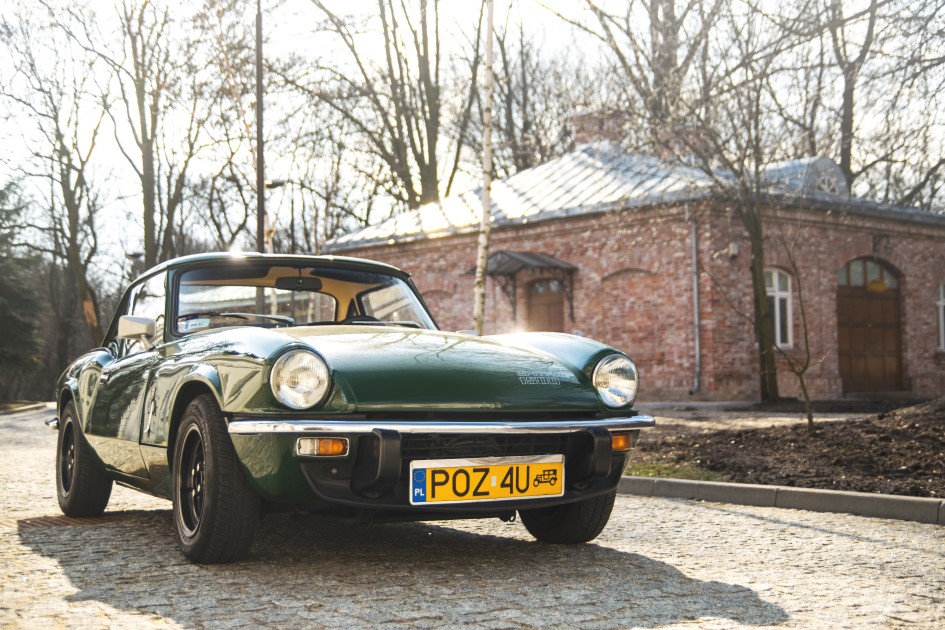[av_image src=’https://www.ardorauctions.pl/wp-content/uploads/2016/11/002_pasek-1500×430.jpg’ attachment=’3173′ attachment_size=’featured’ align=’center’ styling=” hover=” link=” target=” caption=” font_size=” appearance=” overlay_opacity=’0.4′ overlay_color=’#000000′ overlay_text_color=’#ffffff’ animation=’no-animation’][/av_image]
[av_two_third first min_height=” vertical_alignment=” space=” custom_margin=” margin=’0px’ padding=’0px’ border=” border_color=” radius=’0px’ background_color=” src=” background_position=’top left’ background_repeat=’no-repeat’ animation=”]
[av_textblock size=” font_color=” color=”]
Triumph Spitfire 1500 1979
- The last of the classic British roadsters
- Iconic colour combination of British Racing Green exterior and bright interior
- After body and paint restoration
Estimate: 60 000 – 70 000 PLN
Starting price: 40 000 PLN
Chassis number
Technical Specification:
Engine: straight-six, 1.5-litre
Power: 71 break horsepower
Other: four-speed manual gearbox, rear-wheel drive
Legal condition: registered in Poland with vintage (yellow) number plates
Model History
History of the Spitfire dates back to 1957, when Giovanni Michelotti made a draft for a company called Standard-Triumph. Most of the parts were adapted from a saloon car made by the same company, Triumph Herald. After adding some finishing touches, the car was unveiled on the London Motor Show in 1962. Production of the Mark I model began in October in the same year. Fun fact: the was named after the legendary World War II British fighter plane. The car was fitted with a tiny, four-cylinder engine displacing just 1.1 litres. The engine was fitted with two carburettors made by a popular company called SU. The car was positioned on the market as an inexpensive sports car. Its price was reflected in poor equipment. Even by the standards of the day, wind-up windows and manual door locks were no luxury. Despite this, the car was a sales success. First series Spitfire sold in 45.753 examples over the period of two years. Over the years Triumph evolved. New versions – Mark II, III and IV – were introduced in 1964, 1967 and 1970 respectively. Along with introduction of the third series, a new, more modern and more powerful 1.3 litre engine was also made available. Power output rose from 63 to 75 BHP, which significantly improved Spitfire’s performance. Acceleration from 0 to 60 miles an hour was dealt with in 13.4 seconds, whereas top speed was 153 kph. In 1969 significant changes were made to the American market version. Stricter safety and emissions regulations meant lowering the compression ratio and rearranging the interior was necessary. The 1500 model was launched in 1974 as one of the most advanced iterations of the Spitfire series. As its name suggests, it received a modernized engine displacing 1.5 litres. European market models were further differentiated to their American counterparts. Changes regarding styling and technical specifications made European versions much more valuable than the American ones. Production of the Triumph Spitfire 1500 ceased in 1980. Total number of vehicles produced reached 95.829.
Vehicle History
The Triumph Spitfire is definitely one of the most recognizable British cars. Its classic body shape, lightweight handling and relatively easy maintenance made it very popular on the second hand market. The car can bring its driver a lot of joy on summer, weekend drives with the top down. This particular example, presented by Ardor Auctions, was produced in 1979. It remained in the hands of a single Dutch family and was only used as a recreational vehicle. The car was imported to Poland in 2012 with a mileage of 45 thousand kilometres. It was fully functional, but needed some minor repairs done to the body and paint. The owner decided to have a full body restoration performed. It was finished off by painting the car in the most typical Spitfire colour – British Racing Green. From that moment the car has only done 6 thousand kilometres so far. In 2016 the car underwent a substantial maintenance and carburettor adjustment. On top of that, an extra oil radiator was also fitted. The car is fully functional and ready to drive. Its equipment also includes a colour-matching hardtop. The owner will also hand over the complete documentation of the restoration process and bills for new parts.
[/av_textblock]
[/av_two_third][av_one_third min_height=” vertical_alignment=” space=” custom_margin=” margin=’0px’ padding=’0px’ border=” border_color=” radius=’0px’ background_color=” src=” background_position=’top left’ background_repeat=’no-repeat’ animation=”]
[av_gallery ids=’3162,3163,3164,3165,3166′ style=’thumbnails’ preview_size=’portfolio’ crop_big_preview_thumbnail=’avia-gallery-big-crop-thumb’ thumb_size=’portfolio’ columns=’1′ imagelink=’lightbox’ lazyload=’deactivate_avia_lazyload’]
[/av_one_third]
[av_gallery ids=’3167,3168,3169,3170,3171′ style=’thumbnails’ preview_size=’portfolio’ crop_big_preview_thumbnail=’avia-gallery-big-crop-thumb’ thumb_size=’portfolio’ columns=’3′ imagelink=’lightbox’ lazyload=’deactivate_avia_lazyload’]

